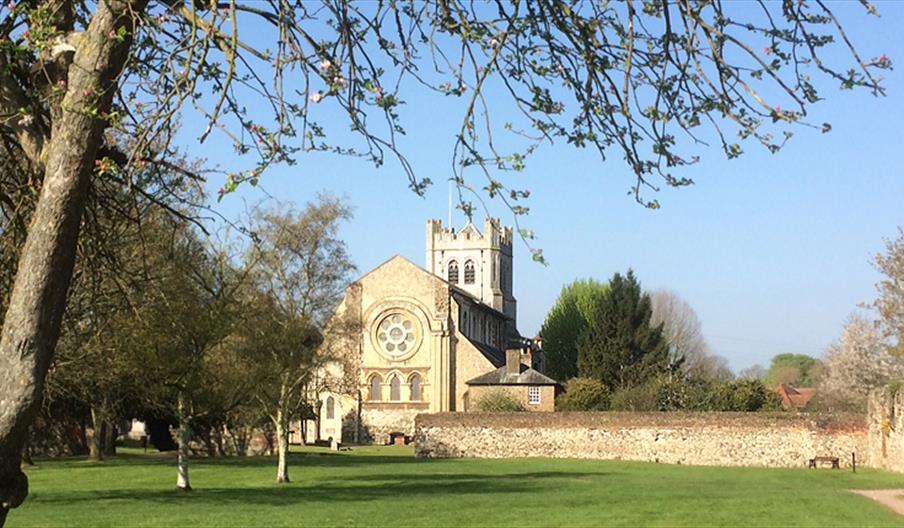Book Tickets Online
About
Welcome to Waltham Abbey Church
The parish of Waltham Abbey is part of the benefice of Waltham Holy Cross (which is itself part of the Deanery of Epping Forest and Ongar Deanery of the Diocese of Chelmsford). There are four Church of England churches within the benefice of which one is the Abbey Church, which is the church of Holy Cross and St. Lawrence and is the parish church of Waltham Abbey. The others are St. Lawrence Church, Ninefields, St. Thomas Church, Upshire and Holy Innocents Church, the parish church of High Beach.
The Friends of Waltham Abbey Church was set up during the 1960s restoration of the church. The aim of the Friends is to help raise money for the upkeep, maintenance and enhancement of the church fabric. Everyone is encouraged to become a member of the Friends of Waltham Abbey Church. We have members all over the U.K. and abroad. You can contact The Friends by emailing friends@walthamabbeychurch.co.uk or by writing to the Parish Office.
The Visitor Centre in the crypt is a vibrant part of church life and supplies many items at reasonable prices including bibles, books, church guides, wrapping paper and cards of various kinds. Very popular are ones for Christmas depicting the church building. The Visitor Centre is manned entirely by volunteers.
Useful links:
Visiting the Abbey Services What's On Groups and Activities Staff
The histrory of Waltham Abbey Church
The first known church in Waltham was built c.610 at the bidding of Sabert, King of the East Saxons and nephew of Ethelbert of Kent. It was a small wooden building, lying within the choir of the present Abbey Church, and would have been a Minster – a church built by a landowner to serve the people who lived in the surrounding area, for this was before the days of parishes, each with its own church. Waltham was the centre of the royal hunting park, and remained a royal property for many centuries.
After Sabert’s death in 617 and the East Saxon kingdom reverted to paganism and did not become Christian again until near the end of the 7th century, with the coming of St Cedd. Sabert’s church, or the memory of it, must have survived, for, in the second half of the 8th century, when the East Saxons had come under the rule of Offa of Mercia, a stone church was built around it, similar to other churches built by Viking settlements in the 9th and 10th Centuries, the church here clearly remained “in business” as the new settlers were converted to Christianity.
During the reign of Cnut (1016-1035), Waltham was given by the king to Tofig, one of his court, who also owned manors in Somerset, and on one of them, a large stone crucifix was found buried in the top of a hill. This was brought to Waltham and hung in Offa’s church, where it soon became an object of pilgrimage for people who came seeking healing by praying before it. It should be stressed that only the most ignorant believed that the Cross itself had healing powers – the cures came from the faith of those who used it as a focus of their thoughts and prayers.
One of those healed by a pilgrimage to Waltham was Harold Godwinson, at that time Earl of Essex and East Anglia and by then the owner of the manor of Waltham. In gratitude, he rebuilt the church on a grander scale, and, when it was consecrated to the Holy Cross in 1060, set up a college of 16 lay canons to serve it and the other villages in the area with which he endowed his foundation. The canons were priests, but they lived in their own houses in the town, and, like most priests at that time, they were allowed to marry and could bequeath their canonries to their sons. Harold’s church building, however, did not long survive, but was replaced in the early 12th century with a new building, the nave of which is still the parish church.
In 1177, Henry II, as part of his penitence for the murder of Thomas Becket, refounded Harold’s college as a priory of Augustinian canons regular – that is, priests who lived together under rule, like monks, but, unlike monks, were not confined within the walls of their monastery, but went out, like their predecessors, to serve the surrounding villages. In 1184, Henry raised his foundation to the status of an abbey, with an abbot, a prior and twenty four canons. The abbot was given the right to wear a ring and a mitre, and a seat on the King’s Council, and the abbey was exempted from the jurisdiction of the bishop, the abbot being responsible directly to the king (this status as a Royal Peculiar was enjoyed by Waltham until 1865, when most of the Royal Peculiars were abolished). Waltham became the most important of all the Augustinian houses in England, and chapters of the order were often held here. The chancel of the Minster church was demolished, and a great new choir and presbytery were built on the east end of the parish nave, making the church three times its present length.
The abbey prospered, and maintained a good reputation, even when monasticism began to decline and fall into disrepute in the 16th century. It was a favourite place to visit for many kings, both for hunting and for religious reasons. Henry VIII particularly valued Waltham as a place to escape the cares of state and enjoy hunting and discussion with the Abbot, a very learned man. During one of his visits, two of his bishops, Fox and Gardner, had a discussion about the king’s marriage problems with Thomas Cranmer, a Cambridge scholar, who was staying with relations here, which led to England breaking away from the Roman Catholic Church. “Superstitious practices”, such as pilgrimages, were abolished in 1536 and it was probably then that the Holy Cross of Waltham ‘disappeared’. The dissolution of the monasteries began, but, probably because of Henry’s liking for Waltham, it was the last abbey (though not the last monastery) to be dissolved, and very nearly became a cathedral. The dissolution of the abbey was an economic disaster for the town, which had depended on it and the pilgrims for employment, and there must have been considerable hardship until the establishment of the gunpowder factory half a century later brought a new source of employment.
After the canons had gone, their part of the church and their domestic buildings were demolished for the valuable stone, but the churchwardens succeeded in saving the parish nave, as it had been the parish church since “time immemorial”. It became Church of England instead of Roman Catholic, and had only a curate instead of the Dean who had been its senior priest since Harold’s time (there was no vicar until 1865). A copy of the Cranmer Bible, named after the Archbishop who commissioned it, and Erasmus’s Paraphrases of the Gospels were chained in the church for anyone to read.
During the reign of Mary I, when an attempt was made to return to Catholicism, a blacksmith from Waltham, William Halliwell, was burned at the stake in Stratford, for heresy, because he did not understand the Catholic teaching about the bread and wine at Communion. His story was told by John Foxe in his ‘Acts and Monuments’, or Book of Martyrs, the English version of which was written in Waltham Abbey during the reign of Elizabeth I. Later, in the early 17th century, that book and Bishop Jewel’s Apologia (a statement of the beliefs of the Church of England) were hung on chains in the church (and in all parish churches) instead of the Bible and Paraphrases, as Bibles by then were cheap enough for families to have their own copies. Not everyone agreed with the teachings of the Church of England, and at least one person from Waltham left for America for religious reasons in 1630. Others were fined for not attending church services, being either still Catholic, or belonging to one or other of the Protestant sects.
During the Commonwealth, Parliament tried to force everyone in England to become Presbyterian, and Waltham had its own Presbytery, or council of elders, whose job was to enforce the rules of their religion, but the incumbent, Thomas Fuller, continued to hold Prayer Book services, and to defeat the elders in the ensuing arguments. All ceremonies (including Christmas) were abolished, and marriage became a civil matter, church weddings being forbidden. The local Justice of the Peace even fined himself for having his daughter married in church!
At the Restoration in 1660, Waltham returned to the pre-Commonwealth forms of worship, the abbey Church still being the only church in the town, but a few years before this, a meeting of the Society of Friends or Quakers was formed in the town and built a meeting-house in what is now Quaker Lane. This was not well received by many of the townsfolk, and when George Fox, the Quakers’ founder, visited the town in 1654, he said, “the people were very rude, gathered about the house and broke the windows”. Quakers were subjected to fines on people who did not attend Church of England services regularly, and the goods of some Waltham Quakers were confiscated and stored in the church crypt when the owners did not pay their fines. The meeting-house later became a school, but was demolished in 1844, when the Quakers left Waltham.
The Church at Waltham continued to flourish, having a succession of able incumbents, even during the late 18th century, when many parishes suffered from absentee vicars. Waltham did, in fact, have one such, but fortunately he appointed good curates in his place. During the late 19th century, the people of Upshire, who had always been in the parish of Waltham Abbey, and had a long way to come to church, began to have services in their school hall. In 1904 the then owner of Warlies, Sir Thomas Foxwell Buxton, had St Thomas’s church built for them, and Upshire became a separate parish. In 1974, after the building of the large Ninefields estate at the east end of the town, St Lawrence Church, Ninefields was established, holding services in the school hall (it is necessary to add ‘Ninefields’ to the dedication, as the Abbey Church is also dedicated to St Lawrence). This has since become a District Church, the first step towards becoming a separate parish. In 1998, a new arrangement was made, whereby the Abbey Church of Holy Cross and St Lawrence, St Thomas Upshire, Holy Innocents High Beach and St Lawrence Ninefields were joined together in a Team ministry in order to foster co-operation between the parishes and make more efficient use of the clergy available.
Map & Directions
Road Directions
M25 (junction 25/26) A121 – Waltham Abbey. The Abbey Church is in Highbridge Street (postcode EN9 1DG).
Car parking is available outside the Abbey Church – free for two hours. Or park in the Cornmill car park behind the Muhinur restaurant, or in the Abbey Gardens car park (accessible from the roundabout on the B194 at the junction of Abbey View and Crooked Mile).
Public Transport Directions
By Rail
To Waltham Cross (1.2 miles) from London Liverpool Street, Hertford East and Cambridge. – Services run approximately every 30 minutes in each direction. For details, contact Greater Anglia.
By Bus
Waltham Abbey is served by several bus routes – for information, refer to Travelline South East and Anglia. Use Find a Timetable and enter Waltham Abbey as the location.












